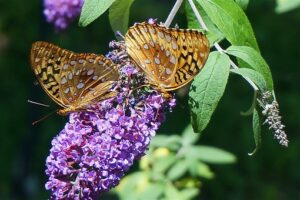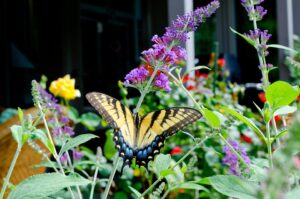How to Plant and Care for Butterfly Bush

Create a natural habitat for pollinators by introducing the butterfly bush in your home garden, this popular perennial thrives in zones 5-9 and belongs to a species of flowering plant in the family Scrophulariaceae.
This garden beauty is also called Buddleja davidii and is native to Sichuan and Hubei provinces of central China and Japan. The butterfly bush is also called orange eye or summer lilac. This perennial bush grows best in tropical and sub-tropical climates.
Most species have hairy leaves with flower bloom colors that range from orange, purple, white, yellow, or pink. The butterfly bush can be grown as a tree or a shrub, if you’re desire is to attract pollinators to your home garden then installing this garden beauty is the right choice. For more on the butterfly bush let’s take a closer look.
The planting location
The butterfly bush grows best in a sunny location, they can also survive partially shaded areas, however, the flowers may be reduced.
The soil type
The soil should be fertile well-drained, slightly acidic to neutral with a ph 6.0-7.5
water requirements
Once established the butterfly bush is drought-tolerant, watering the plant once a week is ideal, the soil should not be waterlogged and should be allowed to dry before another water application.
How to fertilize
Butterfly bush can and will bloom without fertilizer so there is no need to fertilize.
Garden insect pest issues
Although the butterfly bush is resistant against pests keep a watch for these few that may cause some problems.

- Aphids
- Caterpillars
- wasps
- Spider mites
- Spiders
- Japnese beetles
- Ants
Aphids, wasps, spider mites, spiders, and ants can be controlled with insecticides such as insecticidal soap, etc… before pesticide application read and follow the manufacturer’s label for the best results. Caterpillars and Japanese beetles can be controlled mechanically by handpicking and throwing them into a bucket or a container of soapy water.
Diseases of the butterfly bush
There are few diseases that the butterfly bush is susceptible to, if your butterfly bush shows these signs treat them as followed.
- Downy mildew
- Phytophthora
- Rhizoctonia
Downy mildew
Downy mildew is encouraged by fungi, signs include, white to black furry patches on the leaves undersides, and stems. The leaves may turn yellow or brown above the spot, in the more extreme case the entire leaf will turn brown.
Leaves may also become stunted and wilt, the spores spread easily by the wind, to bring control, plants that are severely infected should be removed and properly disposed of. To prevent this disease ensure that the butterfly bush is properly spaced for good air circulation. A continual application of fungicides will offer help, before applying read and follow the label for best results.
Phytophthora
Phytophthora is caused by a fungus that encourages root and crown rot, the spores of this fungal disease inhabit the soil attacking the roots tissues. The roots system turns brown followed by rotting of the outer coating, other symptoms include limp flowers with wilting and yellowing of the leaves along with lower stem rot.
In server cases the entire plant may die, the use of a fungicide containing Fosetyl-Al will offer some help. Read and follow as directed on the label.
Rhizoctonia
Rhizoctonia affects the stem and the root system, this disease is also encouraged by fungus. The plant’s leaves will turn yellow followed by wilting and leaf drop, the flowers also appear to be stunted. The fungal spores inhibit the soil and are difficult to control. Fungicides containing Fludioxonil which is the active ingredient that will help to bring control.
Pruning procedure
Pruning procedures of the butterfly bush involve the removal of diseased, broken, or dead limbs. Pruning can be carried out, any time of the year, spent or faded flowers can also be removed to encourage new shoots and flower buds. Cutting the butterfly bush back to the ground will encourage a more full plant with flower blooms.
Container grown butterfly bush
Butterfly bush can be successfully grown from a container once the requirements are met as discussed above. However, when growing in a container the container should be large enough to accommodate or for your butterfly bush to sit comfortably.
Although butterfly bush is drought-tolerant once established, the container should have drain holes for water drainage. It is also suggested that these plants should be grown in a container for a limited time because of the rate at which they grow.
Additional information
1. The butterfly bush will need extra mulch to act as an insulator in colder climates.
2. During the spring months apply a thin layer of mulch and compost to retain moisture and suppress weeds.
3. In northern climates that get extremely cold spread up to 6 inches of mulch around the trunk of the plant to help it through the winter months. The butterfly bush will die back to the ground in this region during the winter months but will produce fresh growth in the spring.
4. Avoid fertilizing because of more leaf growth rather than flower bloom.
The final word on butterfly bush care
The butterfly bush is a show stopper, this garden beauty will not only give your garden that added flavor but will attract pollinators adding to the beauty of your garden. This plant can be grown as a tree or a shrub, the butterfly bush is a gardener’s favorite and will go to work for you with its beautiful flower bloom that will have your garden buzzing with excitement so go ahead and give the butterfly bush a try, you will be happy with the results. The beautiful bush a gardener’s favorite that will transform your garden and landscapes.
About the author
Norman loves being in the garden, both at home and for his job....
he is 'Natures Little helper' being outdoors, growing his vegetables and flowers from an early age.
Now having spent over 22 years in the profession he want to give some of his knowledge to others...
his vast array of hints and tips you will find scattered over this site will help you no end growing plants in your garden.

This is a beautiful plant! Is it called a butterfly bush because it will attract butterflies? 🙂 You mention it grows best in a tropical environment. I live in TN, how would it grow here? This looks like a fun plant to try to grow in the summer when it’s really warm! Thank you for sharing!
It is and amazing plant, just follow what I layed out in my post and you will be just fine. All the best to you.
This is an article that should be practicalized, having your own butterfly bush farm in your surrounding.
this males it possible for pollination to take place in and around our houses, there are lot of dos and songs, as not allowing least to come close, the site or location of the butterfly bush is also put into consideration
These plants are amazing and will work wonders in your garden. So happy to help.